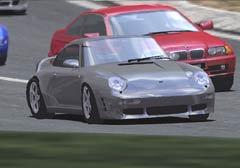
|
| |
In
Gran Turismo, you can't get away with simply holding down the
gas and bouncing off the walls and your opponents and expect
to win. You must realize you are driving a real car and drive
as though you were racing in real life. If you don't know how
to drive in real life either, then you might want to take a
few driving tips from the Gran Turismo Racing School. If you
expect to compete with the best, you had better be able to drive
with the best. |
|
|












